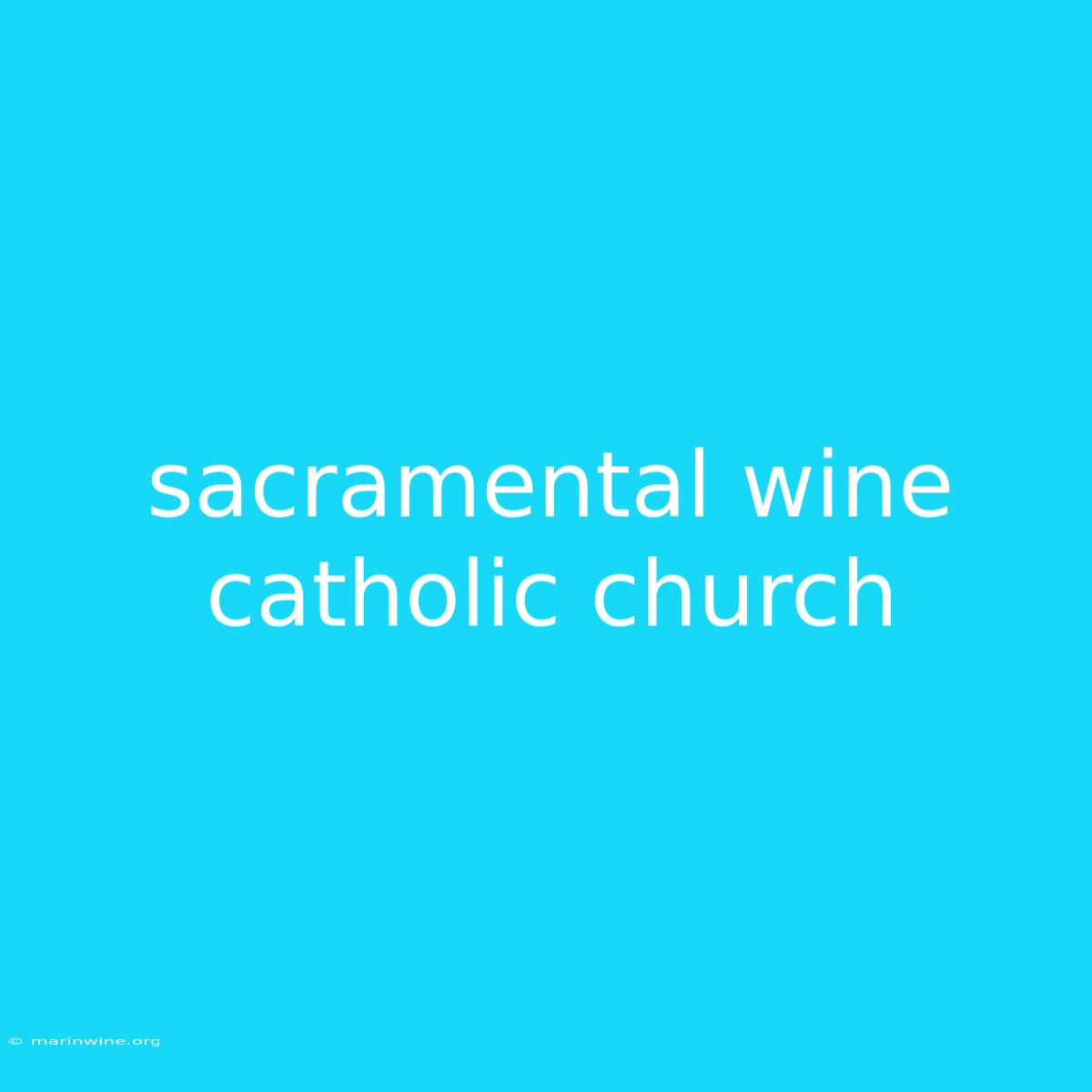The Mystery of the Chalice: Unveiling the Sacramental Wine of the Catholic Church
What is the significance of the wine used in Catholic Mass? It's much more than just a beverage – it's a symbol of Christ's blood and a key component of the Eucharist, one of the most sacred sacraments in the Catholic Church.
Why It Matters: Understanding the sacramental wine used in Catholic Mass is essential for comprehending the profound spiritual meaning behind the Eucharist. It connects us directly to the sacrifice of Christ and allows us to participate in his redemptive work. This article delves into the history, symbolism, and practical aspects of this crucial element of Catholic worship.
Key Takeaways of Sacramental Wine:
| Key Aspect | Description |
|---|---|
| Nature of the Wine | Must be made from fermented grapes, free of additives, and suitable for consumption. |
| Symbolism | Represents the blood of Christ, symbolizing his sacrifice for humanity. |
| Transubstantiation | The belief that the bread and wine are transformed into the body and blood of Christ during Mass. |
| Eucharistic Celebration | A central part of Catholic worship, where believers receive the body and blood of Christ through communion. |
Sacramental Wine: A Deep Dive
The History of Wine in the Eucharist
The use of wine in the Eucharist dates back to the Last Supper, when Jesus shared bread and wine with his disciples, instituting the sacrament. Early Christians understood wine as a symbol of Christ's blood, representing the covenant established through his sacrifice. This practice continued throughout the centuries, becoming a cornerstone of Catholic tradition.
The Significance of Wine as a Symbol
The use of wine as a symbol of Christ's blood is rooted in several key interpretations:
- Life-giving Power: Wine, fermented from grapes, symbolizes the life-giving power of Christ's sacrifice. Just as grapes are transformed into wine, Christ's death and resurrection bring new life to believers.
- Shared Sacrifice: Drinking wine together during Mass signifies the shared sacrifice of Christ and the unity of believers in his body.
- Spiritual Nourishment: The wine, as the blood of Christ, nourishes our souls and strengthens our spiritual connection with God.
The Theology of Transubstantiation
Catholic belief holds that during the consecration of the bread and wine, the substance of the elements is transformed into the body and blood of Christ, while the appearances remain the same. This doctrine, known as transubstantiation, emphasizes the real presence of Christ in the Eucharist. It means that when Catholics receive the bread and wine, they are truly receiving Christ himself.
Wine in the Eucharist: Practical Considerations
- The Type of Wine: The wine used in the Catholic Mass must be made from fermented grapes and be free from additives, ensuring its suitability for consumption and symbolic representation.
- Non-Alcoholic Options: For individuals who abstain from alcohol due to medical or personal reasons, non-alcoholic wine or grape juice can be used. However, the Catholic Church emphasizes that the use of grape juice is not a substitute for wine, but rather an exception.
- The Significance of Sharing: The shared act of receiving communion with wine represents the unity of the Church, the shared sacrifice of Christ, and the spiritual nourishment we receive.
FAQ Regarding Sacramental Wine
Q: Can I bring my own wine to Mass?
A: No. The wine used in Mass must be provided by the parish and approved by the priest.
Q: Why does the wine sometimes taste different?
**A: ** The type and quality of wine can vary between parishes, depending on availability and local preferences.
Q: What happens if someone accidentally spills the wine?
A: Spilling the consecrated wine is not a grave sin, but it is treated with respect. It is usually cleaned up carefully and disposed of in a dignified manner.
Q: Why is it important to receive the Eucharist, even if you don't drink alcohol?
A: The Eucharist is a sacrament, a visible sign of an invisible grace. It's about the spiritual nourishment we receive from Christ, not the taste of the wine.
Q: Can I receive the wine alone, without the bread?
A: No. Catholic tradition emphasizes receiving both the bread and wine as a complete whole, symbolizing the body and blood of Christ.
Tips for Understanding and Participating in the Eucharist:
- Learn about the history and symbolism of the Eucharist. Understanding the theological and historical context of the sacrament enhances its meaning and spiritual depth.
- Observe the Mass with attentiveness. Pay attention to the prayers, readings, and actions that take place.
- Communicate with your priest or parish staff. If you have questions or concerns about the sacrament, don't hesitate to reach out for clarification.
- Participate in the Eucharist with reverence and devotion. This sacred act deserves our respect and attention.
Summary by Sacramental Wine
The sacramental wine used in Catholic Mass is a powerful symbol of Christ's blood, representing his sacrifice and the spiritual nourishment he offers us. By understanding the historical context, the symbolism, and the practical considerations surrounding this element of the Eucharist, we deepen our appreciation for this central sacrament of the Catholic Church. Through participation in the Eucharist, we are united with Christ, strengthened in our faith, and nourished by his love.

